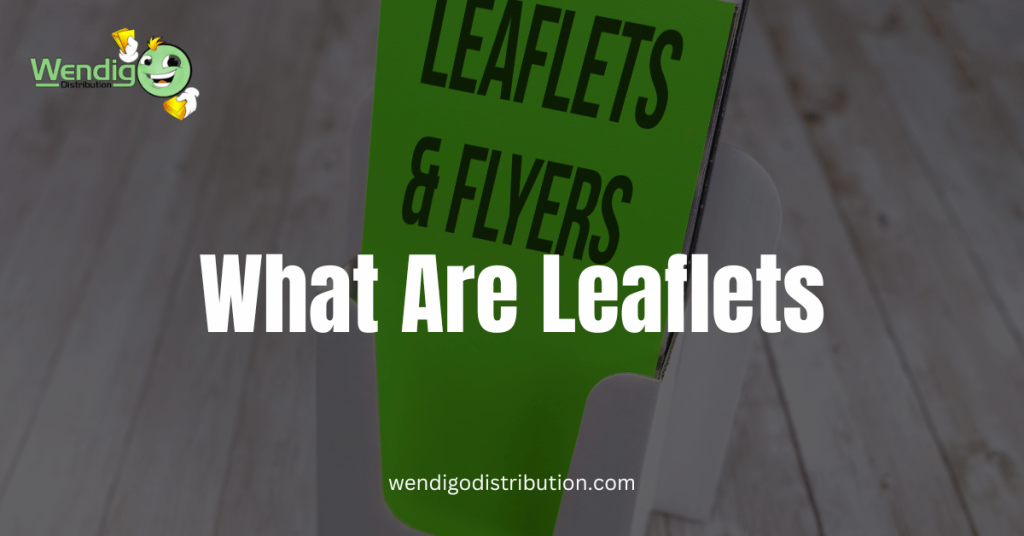As a business owner, effective marketing and communication are essential to your success. To reach customers and spread your message, you need to leverage every tool at your disposal. One such tool that is often overlooked is the leaflet. Leaflets are printed promotional materials that provide an easy way to raise brand awareness and drive interest in your products or services. In this quick guide, we will explore what are leaflets, examine their benefits, and provide tips for designing and distributing an effective leaflet campaign. By the end, you will have a clear understanding of how to make the most of leaflets to achieve your business goals. So let’s dive in and discover how leaflets can work for you.

The Definition and Purpose of Leaflets
Leaflets are printed materials used to convey information to a wide audience. Their purpose is to educate readers and raise awareness about a topic, product, service or event in a concise yet compelling manner.
Leaflets typically contain:
- An eye-catching headline to grab attention. This is followed by a brief intro paragraph highlighting the key message or purpose.
- Short blocks of text with informative headings to make content scannable. Use bullet points for easier readability. Keep sentences and paragraphs brief while covering main points.
- Visuals like photos, illustrations, charts or graphs to break up text and reinforce key messages. Images should take up about 1/3 of the total space.
- A clear call-to-action like “Visit our website for more details” or “Call today to schedule an appointment”. Provide contact information like a phone number, email and physical address.
- A balanced and consistent page layout with good use of white space, alignment and font sizes for easy navigation. Group related ideas together.
In summary, leaflets are a useful promotional tool for organizations and businesses to disseminate information, advertise products and services, announce events or launch marketing campaigns. When designed well, leaflets can be an effective way to raise brand awareness and drive customer engagement.
Types of Leaflets: Flyers, Pamphlets, Brochures and Booklets
Leaflets are printed informational materials used to convey messages to readers. There are several common types of leaflets, including:
Flyers are single sheets of paper with information on only one side. They are often distributed to raise awareness about an event, product, or service. Flyers typically have eye-catching designs and minimal text to quickly capture attention.
Pamphlets contain more in-depth information on a topic. They have multiple pages stapled together, with text and images on both sides of each page. Pamphlets aim to educate readers or persuade them to take action. They may include diagrams, statistics, or testimonials to support key points.
Brochures are multi-page, folded leaflets that provide an overview of a company, organization or product. Brochures have a professional design and use high-quality paper to convey a polished image. They contain images, descriptions, and contact information or purchasing details. Brochures are a popular marketing tool for businesses.
Booklets take the form of a small book, with multiple pages bound together. They explore a subject in depth through lengthy descriptions, images, and a clear structure or outline. Booklets are an excellent format for step-by-step guides, research reports, or product manuals.
In summary, leaflets encompass a variety of printed materials for communicating information to audiences. By understanding the different types of leaflets, you can choose a format suited to your particular needs and goals. The options range from simple flyers to more substantial booklets, allowing you to provide anything from a quick introduction to an in-depth learning resource.
How to Design an Effective Leaflet
A leaflet is a printed piece of paper that contains information about a product, service or issue. Leaflets are a popular and effective way for organizations to spread their message and raise awareness among the public. To design an impactful leaflet, follow these steps:
Make the leaflet visually appealing. Use images, graphics, and an engaging layout to capture interest. Select high-quality images that relate directly to the topic or are metaphorically meaningful. For the best results, use a professional design software like Canva or Adobe InDesign.
Focus on a single, clear message. Decide on the primary goal or call-to-action for the leaflet. All content should directly support that key message to avoid confusion. Use bullet points or numbered lists to highlight the main points.
Write in a friendly yet professional tone. Address the reader directly as “you” to make a personal connection. Use simple and concise language for an 8th grade reading level. Explain any technical terms.
Include all essential information. Provide details on what, where and when, and ensure contact information like phone numbers, emails and websites are prominently displayed. Give the reader next steps to take.
Leave plenty of white space. Do not crowd the page with too much text or too many images. White space gives the reader’s eyes a rest and makes the content more inviting and scannable. Aim for short sentences, paragraphs, and sections.
Proofread thoroughly. Double check for any spelling, grammar or punctuation errors before printing and distributing. Have another person also review to spot any mistakes.
An effective leaflet requires a strategic combination of visual design, concise and compelling content, and a clear call-to-action. Following these best practices will enable you to create a professional and impactful leaflet. Distribute your leaflets to spread awareness and motivate people to support your cause or organization.
Leaflet Distribution Methods: Getting Them Into the Right Hands
Leaflet distribution involves getting physical promotional materials into the hands of potential customers or clients. There are several tried-and-true methods for distributing leaflets to maximize exposure and response.
Hand-to-Hand Distribution
This labor-intensive approach involves stationing people at strategic locations to directly hand out leaflets to passing individuals. While time-consuming, it allows for a personal connection and the ability to briefly explain the key message or offer. It is best for locations with heavy foot traffic, such as downtown areas, university campuses, or special events.
Door-to-Door Delivery
For residential campaigns, dropping leaflets directly to homes via door-to-door delivery is an option. This ensures each household receives the information but requires significant time and resources. It also risks annoying some recipients or being seen as intrusive. However, for smaller neighborhoods or areas with less access to mail delivery, it can be an important method.
Mail Delivery
Working with a mailing service to deliver leaflets through regular post is a popular choice for broad distribution. Using residential mailing lists, leaflets can be sent directly to households across a wide geographic range. However, there is a risk of the leaflets being discarded as “junk mail.” Creative and eye-catching design is important, as is targeting the correct demographic to increase open and response rates.
Vehicle Placement
For some campaigns, placing leaflets under vehicle windshield wipers in high-traffic parking lots is ideal. This is a quick way to reach many people in a specific location. However, it does waste materials on empty vehicles, and leaflets may be viewed as litter. Proceed with caution and only distribute in appropriate, lawful locations.
Newspaper Insertion
Including leaflets as inserts in local newspapers, community newsletters or magazines allows you to reach readers that already have an interest in the publication’s content. Partnering with the publication to become an insert advertiser puts materials directly into the hands of engaged readers and has a high perceived value. However, it can be expensive and still risks the leaflet being discarded.
In summary, the key to successful leaflet distribution is using a multi-pronged approach, targeting your audience precisely, keeping the message clear and concise, and making the materials eye-catching enough to capture interest. With the right combination of methods, you’ll get your leaflets into the proper hands.
Leaflet Marketing Strategy: Why Leaflets Work
Leaflet marketing is an effective strategy for businesses looking to increase brand awareness and drive sales. Leaflets are informative print materials that are distributed to target audiences. When creating a leaflet marketing campaign, there are several factors to consider:
Define Your Goals
First, determine the goals and objectives you want to achieve with your leaflet campaign. Do you want to promote a new product or service? Increase store traffic? Boost brand recognition? Clearly defining your goals will help guide the design and distribution of your leaflets.
Target Your Audience
Identify your target audience and create leaflets tailored to their needs and interests. Consider factors like age, location, gender, income level, and lifestyle. The more tailored your message is to your audience, the more effective it will be. Focus on benefits that would be most appealing and relevant to them.
Create Compelling Content
Develop content for your leaflets that captures attention and fuels interest in your brand or products. Use an eye-catching design with visuals like photos, graphics, or illustrations. The headline and first paragraph are critical for quickly engaging readers. Provide relevant information on products, services, special offers, or events. Include a clear call-to-action like “Call now” or “Visit our website.” Keep text brief and scannable using bullet points and short paragraphs.
Strategic Distribution
Distribute your leaflets where your target audience is most likely to encounter them, such as on vehicles, in mailboxes, in high-foot traffic areas, or through direct mail. Consider working with local businesses to display your leaflets in their stores or offer them as takeaways for customers. The broader your distribution, the more people will see your message.
Leaflet marketing is a proven and cost-effective way to spread awareness of your brand when done strategically. By defining your goals, targeting your audience, creating compelling content, and ensuring wide distribution, your leaflet campaign is more likely to drive real results.
Conclusion
As you have now learned, leaflets are an informative and persuasive print marketing tool used to spread awareness about a product, service, or cause. By understanding the elements of an effective leaflet including content, design, imagery, and distribution strategy, you can create a leaflet to achieve your outreach goals. With some time and effort, you’ll be producing professional leaflets to share your message with the world. The next time you see a leaflet, you’ll have a deeper appreciation for how much thought and care went into crafting it. And the next time you have something you want to promote, you’ll know just the right tool for the job.
People Also Ask Questions About What Are Leaflets
What are leaflets?
Leaflets are single-page, printed promotional materials commonly used for advertising, marketing, or conveying information about a product, service, event, or cause. They are typically distributed in public spaces, handed out to individuals, or included in mailings to reach a wider audience.
What is the purpose of a leaflet?
The main purpose of a leaflet is to communicate key messages concisely and effectively. They are designed to capture the attention of the target audience, raise awareness, promote a specific offer or event, encourage engagement, and prompt recipients to take the desired action, such as making a purchase or attending an event.
What are the common features of a leaflet?
Leaflets usually have a visually appealing layout, incorporating images, graphics, and concise text to convey information. They may include headings, subheadings, bullet points, and contact details. Additionally, they are often printed in full color on glossy or matte paper to enhance their overall quality.
How are leaflets different from brochures?
While leaflets are single-page documents, brochures consist of multiple pages, typically folded to create a booklet-like format. Leaflets are more suitable for straightforward and quick messaging, whereas brochures allow for more extensive content and detailed information about a product, service, or organization.
What are the advantages of using leaflets for marketing purposes?
Leaflets offer several advantages, such as cost-effectiveness, ease of distribution, and the ability to reach a large audience quickly. They can be distributed through various channels, including direct mail, in-store displays, trade shows, and handed out in high-traffic areas, making them a versatile marketing tool.
